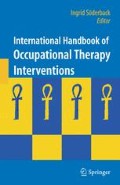Abstract
Intervention for children with disabilities should be anchored in an activity-based approach and use everyday life as a source of children’s learning opportunities. A wide range of assistive devices is available to support everyday activities in children with different types of problems in functioning. Providing these children with assistive technology can be an important intervention strategy for improving functional abilities, improving caregiving, and encouraging participation in everyday activities. Further research is needed to enhance our knowledge of how assistive devices can benefit children and their families to help to guide clinicians in day-to-day practice.
Access this chapter
Tax calculation will be finalised at checkout
Purchases are for personal use only
References
Besio, S. (2002). An Italian research project to study the play of children with motor disabilities; the first year of the activity. Disabil Rehabil, 24, 72–79.
Brodin, J. (1999). Play in children with multiple disabilities: play with toys—a review. Int J Disabil Dev Educ, 46, 25–34.
Campbell, S. (1999). Models for decision-making in pediatric neurologic physical therapy. In: Campbell, S., ed. Decision-Making in Pediatric Neurologic Physical Therapy (pp. 1–22). New York: Churchill Livingstone.
Copley, J., and Ziviani, J. (2004). Barriers to use of assistive technology for children with multiple disabilities. Occup Ther Int, 11, 229–243.
Dunst, C.J., and Raab, M. (2004). Parents’ and practitioners’ perspectives of young children’s everyday learning environments. Psychol Rep, 93, 251–256.
Fallon, K.A., Light, J.C., and Page T.K. (2001). Enhancing vocabulary selection for preschoolers who require augmentative and alternative communication. Am J Speech-Lang Pathol, 10, 181–195.
Floyd, F.J., and Gallagher, E.M. (1997). Parental stress, care demands, and use of supportive services for school-aged children with disabilities and behavior problems. Fam Rel, 46, 359–371.
Haley, S.M., Coster, W.J., Ludlow, L.H., Haltiwanger, J.T., and Andrellos, P.J. (1992). Pediatric Evaluation of Disability Inventory (PEDI). Development, Standardization and Administration Manual. Boston: Boston University.
Henderson, S., Skelton, H., and Rosenbaum, P. (2008). Assistive devices for children with functional impairments: impact on child and caregiver function. Dev Med Child Neurol, 50, 89–98.
Judge, S. (2002). Family-centered assistive technology assessment and intervention practices for early intervention. Infants Young Child, 15, 60–68.
Korpela, R.A., Säppanen, R.-V., and Koivikko, M. (1993). Rehabilitation service evaluation: a follow up of the extent of use of technical aids for disabled children. Disabil Rehabil, 15, 143–140.
Long, T., Huang, L., Woodbridge, M., Woolverton, M., and Minkel, J. (2003). Integrating assistive technology into an outcome-driven model of service delivery. Infants Young Child, 16, 272–283.
McGrath, P.J., Goodman, J.T., Cunningham, S.J., MacDonald, B.-J., Nichols, T.A., and Unruch, A. (1985). Assistive devices: utilization by children. Arch Phys Med Rehabil, 66, 430–432.
Msall, M.E., Tremont, M.R., and Ottenbacher, K.J. (2001) Functional assessment of preschool children: Optimizing development and family supports in early intervention. Infants Young Child, 14, 46–66.
Østensjø, S., Carlberg, E.B., and Vøllestad, N.K. (2003). Everyday functioning in young children with cerebral palsy: functional skills, caregiver assistance and modifications of the environment. Dev Med Child Neurol, 45, 603–612.
Østensjø, S., Carlberg, E.B., and Vøllestad, N.K. (2005). The use and impact of assistive devices and other environmental modifications on everyday activities and care in young children with cerebral palsy. Disabil Rehabil, 27, 849–861.
Palisano, R., Rosenbaum, P., Walter, S., Russell D., Wood, E., and Galuppi, B. (1997). Development and reliability of a system to classify gross motor function in children with cerebral palsy. Dev Med Child Neurol, 39, 214–223.
Parette, H.P., Jr., Brotherson, M.J., and Huer, M.B. (2000). Giving families a voice in augmentative and alternative communication decision-making. Educ Train Mental Retardation Dev Disabil, 35, 177–190.
Sullivan, M., and Lewis, M. (2000). Assistive technology for the very young: creating a responsive environment. Infants Young Children, 12, 34–52.
US Government. Accessibility & Workforce Division, in the U.S. General Services Administration’s Office of Government-wide Policy. Assistive Technology Act of 1998. S.2432. Sec. 3. Definitions and rule. 105–394, HYPERLINK “http://www.section508.gov/docs/AT1998.html Retrieved 5/3 2009 http://www.section508.gov/docs/AT1998.html Retrieved 5/3 2009.
Valvano, J. (2004). Activity-focused motor interventions for children with neurological conditions. Physical and Occupational Therapy in Pediatrics, 24, 79–107.
Author information
Authors and Affiliations
Editor information
Rights and permissions
Copyright information
© 2009 Springer Science+Business Media, LLC
About this chapter
Cite this chapter
Østensjø, S. (2009). Assistive Devices for Children with Disabilities. In: Söderback, I. (eds) International Handbook of Occupational Therapy Interventions. Springer, New York, NY. https://doi.org/10.1007/978-0-387-75424-6_12
Download citation
DOI: https://doi.org/10.1007/978-0-387-75424-6_12
Publisher Name: Springer, New York, NY
Print ISBN: 978-0-387-75423-9
Online ISBN: 978-0-387-75424-6
eBook Packages: MedicineMedicine (R0)

